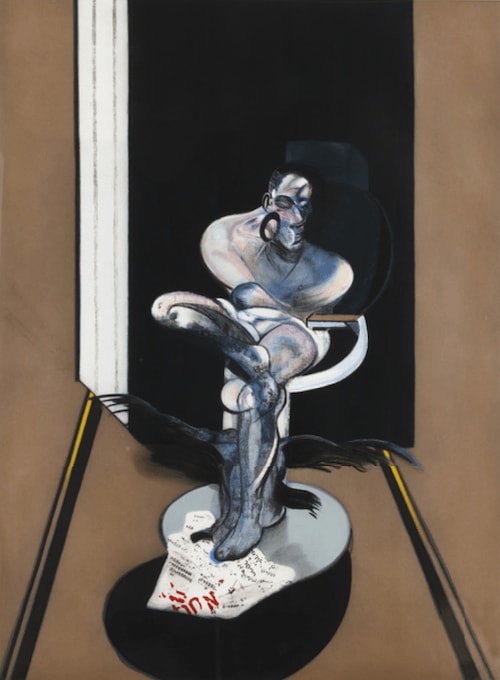
Francis Bacon
163 x 121 cm
Francis Bacon’s Seated Figure, derived from his 1977 oil painting of the same name, is a compelling exploration of spatial manipulation and psychological intensity. This work exemplifies Bacon’s ability to disrupt conventional perspective in order to evoke a sense of instability, disorientation, and existential unease. As with many of Bacon’s compositions, Seated Figure does not merely depict a subject within space—it fractures space itself to mirror the fractured nature of human consciousness.
At the heart of the image lies Bacon’s radical treatment of perspective. Rejecting the traditional rules of linear geometry, Bacon constructs an environment that is both implausible and deeply evocative. The space is fragmented and contradictory, creating a visual tension that permeates the entire composition. The seated figure appears simultaneously solid and unstable, as if its body is caught mid-dissolution—disjointed limbs stretching at unnatural angles, muscles exaggerated or collapsing under invisible pressure. The body seems not to inhabit the space, but to struggle against it, as though reality itself is pressing in from all sides.
The chair, a recurring motif in Bacon’s work, is rendered with formal ambiguity. Its circular base contrasts sharply with the rigid, angular backdrop, suggesting conflicting spatial planes that do not resolve into a coherent whole. The effect is architectural dissonance: a sculptural tension between curves and lines that destabilizes the figure’s position within the frame. The result is a sensation that the figure is neither securely seated nor entirely suspended—a liminal presence teetering between confinement and collapse.
Bacon’s manipulation of space oscillates between depth and flatness. The background is largely a deep, uniform black, devoid of texture or narrative detail, functioning as a void into which the figure threatens to disappear. Yet, within this vacuum, Bacon introduces curved lines—the arc of the chair, an oval beneath the figure—that suggest a shallow stage or plinth. This interplay between flatness and three-dimensional illusion intensifies the visual tension: the figure seems to emerge from and sink into the void simultaneously, caught in a state of perpetual flux.
Two sharply angled lines flank the figure, converging toward the center like theatrical spotlights or the vanishing lines of a distorted perspective grid. These lines act as visual conduits, drawing the viewer’s gaze inward and downward, creating a funnel-like effect that concentrates psychological pressure on the figure. This subtle architectural device compresses the pictorial space, reinforcing a sense of claustrophobia. The figure, pinned between the abstract geometry of the chair and the force of these converging lines, appears subjected to an almost gravitational pull—physically and emotionally compressed.
This spatial distortion is not merely aesthetic; it is psychological. Bacon uses perspective not to represent space, but to externalize states of mind. The contorted pose of the figure, its grotesque proportions, and its lack of a fully defined face all contribute to a sense of inward collapse. The body becomes a site of torment, a physical manifestation of psychic anguish. It is as if the figure is imploding under the weight of its own existence—an embodiment of anxiety, introspection, and the unbearable pressures of consciousness.
The ambiguity of form and space prevents the viewer from finding visual rest. There is no stable viewpoint from which to make sense of the image. This denial of comfort or clarity is central to Bacon’s vision: he wants the viewer to share in the unease, to feel the instability and tension that the figure endures. In this way, Seated Figure functions as more than a portrait—it is an existential diagram, a study in psychological compression and human fragility.
Bacon’s use of distortion, in both the figure and its spatial container, becomes a powerful metaphor for the inner workings of the mind under duress. The viewer is made to confront not only the torment of the figure, but their own discomfort in attempting to read the space. The instability of the composition mirrors the instability of identity itself—a core theme in Bacon’s work. The body is no longer a fixed vessel of the self, but a vulnerable, mutable entity at odds with the structures that surround and confine it.
In the end, Seated Figure is not simply a depiction of a man in a chair, but a visual manifestation of existential tension. Bacon transforms the mundane into the metaphysical, turning spatial distortion into emotional truth. Through its skewed geometry, compressed architecture, and tortured anatomy, the image forces us to reckon with the disordered architecture of the human experience—one where clarity is fleeting, space is unreliable, and the body is always on the verge of unraveling.
For more information on Francis Bacon’s Seated Figure or to buy Francis Bacon’s After Seated Figure contact our galleries using the form below.